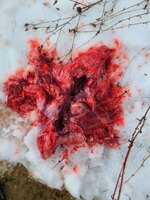I've been working on trying to summarize the "small caliber for big game' argument into a quick "best practices" summary. Here is my first draft. I'd love feedback, edits and ideas of what is missing or shouldn't be in here:
The Best Practices For Affective and Humane Killing of North American Big Game
or
The Form Rokslide Way
1- The number one reason for wounding loss is that we as shooters suck.
2- To suck less, we need to practice weekly throughout the year with field and stress simulating drills.
3- A shooter's accuracy and ability to visually track an animal after the shot and apply an accurate follow-up shot is significantly worse as recoil increases.
4- Furthermore, a traditional high-recoil hunting rifle discourages hunters from practicing a lot which results in even poorer accuracy and field performance.
5-Shooters should practice and hunt with guns with less than 6.5 fp of recoil.
6- The quickest way to incapacitate and kill an animal is through a larger permanent wound channel with the ideal average diameter being 2 1/2" with diminishing returns (and more meat loss) when wound channels go beyond that.
7-Softer and more frangible bullets are much more effective at creating this size of wound channels than the typical bonded or mono-metal type bullets commonly sold as more effective on big game.
8- So-called tougher game animals do not pose a penetration challenge for softer frangible bullets
9-Given these facts-- the "best practice" for ethically and effectively killing game animals is to use smaller than typical calibers such as .223, .243/6mm and 6.5mm using a softer more frangible bullet than the typical recommendation. Examples of these bullets are Hornady ELD-X, ELD-M and Berger Elite Hunter.
10-The large majority of shooters should not consider ever taking a shot on an animal beyond 500 or 600 yards. There are various ways to test one's limits and to train to become better that one can explore, but wounding loss on animals goes up drastically beyond 400 yards and hunters typically overestimate their affective max shooting range by double to triple.
11-A hunting rifle should be built in a way that requires near zero maintenance to operate smoothly and to reliably hold zero. Tikka is a great low-cost option.
12-There are only a few scopes that are reliable enough to hold their zero through years of rigorous hunting use and these should be utilized to reduce zero shift and wounded or missed animals. Any scope from Nightforce or SWFA as well as many scopes from Trijicon and one scope from Maven all have passed rigorous testing. Scope power need not be any higher than 15 for hunting.
13-A new rifle should be dissasembled, degreased, and re-assembled using blue loctite, nail polish or paint pen as thread locker. If there is a lot of play between action and stock consider bedding. Action screws should be torqued to 55 or 60 fps, ring to rail screws should be torqued to 40 fps, and scope ring screws torqued to 30 fps.
14-A rifle should be zeroed by shooting a group of 10-15 rounds (cooling every 3-4 rounds) and then adjusted so the center of the resulting cone of fire is at the center of the target. A 10 round group of less than 1 MOA is quite rare and the difference between that rare gun and one that averages 1 to 1.5 MOA in field hunting affectiveness is nil.
15-Don't worry about cleaning your gun, ever.

